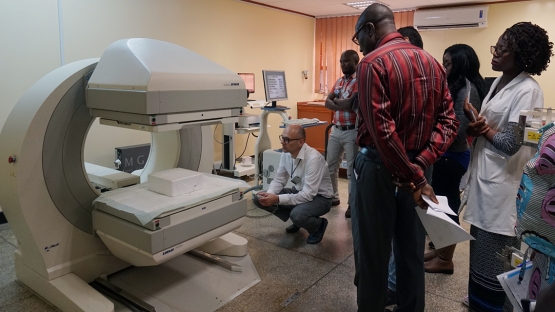Despite growing needs, opportunities for professionals in Africa to receive training in nuclear medicine are limited due to shortage of experienced staff, facilities and equipment. To address this need, the IAEA organised a course in Lusaka, Zambia last week for medical physicists, radiologists, technicians and regulators from across the region to improve their technical skills in assuring safety in nuclear medicine.
“Patient safety and radiation protection can be improved when staff and the regulatory authority understand the benefits and the risks,” said Debbie Gilley, Radiation Protection Specialist at the IAEA. “The goal with the training was to increase awareness and skills in the medical community. This training provided a comprehensive foundation focusing on the safe use of radiation in nuclear medicine.”
Twenty-eight professionals from hospitals and regulators in 19 African countries learned about justification on whether to use nuclear medicine for a particular diagnosis, and if so which nuclear medicine and digital imaging modality to use. They also learned about the importance of quality assurance of equipment used in nuclear medicine. The course was supported by the IAEA technical cooperation programme.
“The course enhanced my knowledge and skills on the various topics related to radiation protection safety, particularly quality control and assurance,” said Mercy Mbuende, a radiation physicist at the Namibian National Radiation Protection Authority. “It was really beneficial to understand the technical issues related to diagnostic imaging and therapy, the importance of quality control tests and the science behind all this.”
Nuclear medicine techniques are often used to evaluate the function of any organ or structure in the body. They provide unique information and offer the potential to identify diseases in early stages. They are also used for treatment of some diseases and health conditions. As they involve exposure to radioactive material, there is an inherent risk that the dose received by the patient is too high or too low. A too high dose would expose the patient to undue risk, while using too little radioactive material can mean that the patient has to go through the imaging or treatment process again.
“One of my learnings from the training was a need for staff training in order to improve radiation safety,” said Veronica Kangwa Sunkutu-Sichizya, Head of Radiology at the University Teaching Hospital in Lusaka. “Through this training course, I also came to realise a need to develop short annual refresher courses on radiation protection for all members of my staff working in nuclear medicine.”
The IAEA will organise a similar training course in French in Niamey, Niger this November, as part of its ongoing efforts to educate about patient safety.
“Safety and quality are equally important in nuclear medicine procedures,” said Gilley. “This and the coming course will help African countries make better use of well-justified and optimised nuclear medicine procedures.”
This year’s IAEA Scientific Forum on Nuclear Techniques in Human Health: Prevention, Diagnosis, and Treatment will also include sessions on patient safety. The Forum is taking place on 19-20 September in Vienna.





